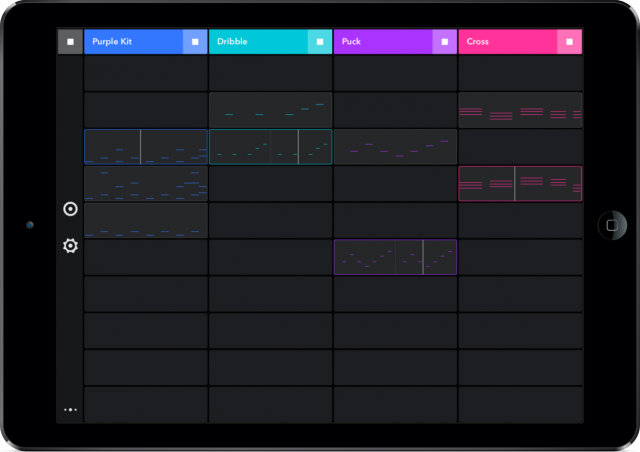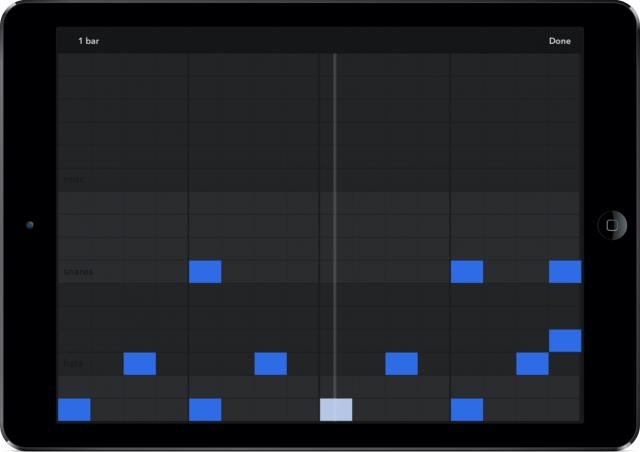It’s been asked over and over again: can a simpler software tool attract more people to music making? But the next question is, invariably – what’s the right stuff to leave out?
Auxy, released today, is an extreme exercise in app minimalism. It radically reduces what’s in the UI by focusing on making and cueing patterns — and leaving out the rest.
It’s also free.
Built exclusively for iPad, Auxy centers on a grid as its main screen. You’ve got four tracks in which you can create, edit, then trigger different patterns. Tap on one rectangle, and you draw in patterns in a familiar “piano roll” sequencer view. Drag notes to draw, then drag to move or elongate them. It’s even easy for clumsy or large fingers.
Each pattern is one, two, or four bars. There’s a drum kit with three sets of sounds, a bass track with four sounds, and two synth tracks with a choice of five sounds. Tapping a circular icon on the left brings up clever draggable knobs for controlling a filter, volume, and (in all but the drum kit) one sound parameter.
The basic functionality is clearly borrowed from Ableton Live. Each column is a track, and can trigger just one pattern at a time. Playback is quantized to the bar. There’s even a stop button at the top of each column.
It’s all so obvious, that you’d be forgiven for thinking this exists already. Weirdly, it doesn’t. You can try an experiment: open up Apple’s GarageBand on iOS and see how long it takes you to get to this same editing view. I stumbled around the UI for a couple of minutes before I found it, and once I got there, tapping tiny icons apparently supposed to represent the piano roll editor and puzzling over what a pencil toggle with a lock meant, I realized it’s nothing like Auxy. My feeling that I had seen Auxy before was more to do with a sense that this is how touch piano rolls should work, more than how they generally do.
So, combining this sort of editor with Live-style triggering is great. The problem is, that’s where the app ends. It’s almost as easy to write a missing feature list as a feature list – even if that’s by design:
You can’t record external audio.
You can’t play in patterns – you can only drag in notes in the piano roll.
You can’t sequence other apps.
You’re limited to a small handful of sounds, and always drums, bass, synth, synth.
You can’t change time signatures.
You can’t export patterns as MIDI.
You can export audio. Tap the record button in the upper left-hand corner, and Auxy lets you live record an arrangement by triggering different clips. When you’re done, you’re given an option to save the audio to iTunes, copy it to another app with AudioCopy, or use iOS 8’s new share functionality (which connects to AirDrop and other apps you’ve installed, like Dropbox).
Using audio export, you can find some use for the app. The developers of Auxy clearly have some talented friends, and so in addition to the slick demo video, you can listen to a whole track made in the app:
I love the minimalism, in that it makes an app that’s uncommonly friendly to beginners. But just allowing an easy point of entry isn’t enough to make software a success: you need a compelling reason to keep using it.
And I can’t help but feel that Auxy isn’t just minimal: it’s a beautiful tool, but it falls just short of some real-world use after an initial play. If it worked with inter-app MIDI, it might become my go-to pattern maker for the various interesting synths you can now collect on iOS. If it exported MIDI (or, as KORG recently showed, Ableton sessions), it could be the perfect mobile idea recorder. That’d be doubly true if there were an iPhone version; that seems a missed opportunity with this compact interface, especially with roomier iPhones 6.
And I don’t think that’s just because I’m a “pro” user. The typical non-producer musician often cares more about mic input than us electronic folks – because they sing, or play guitar, for instance. Once you have something with a mic input, it becomes more personal.
Stockholm-based developer Henrik Lenberg, a veteran of SoundCloud and Propellerhead, is evangelical in his commitment to Auxy and its less-is-more approach. I think the key question is what happens in its next revision.
It’s easy to see how so many music creation tools have become massive bundles of features: even beginners and amateur musicians often cover a wide gamut of use cases. Finding a narrower set of features that still appeals to a broad range of people is a bigger challenge.
But I don’t think Auxy has really tackled that challenge yet. As version 1.0, Auxy is a compelling demonstration of design discipline. If that discipline can be applied to providing a broader range of possible sounds, and some ability to use Auxy as a sketchpad for other music (with MIDI and Ableton export, for instance), I think it could be a landmark tool. For now, less is less – but it could be more.
Auxy is a free app, so grab it now and watch it grow.


